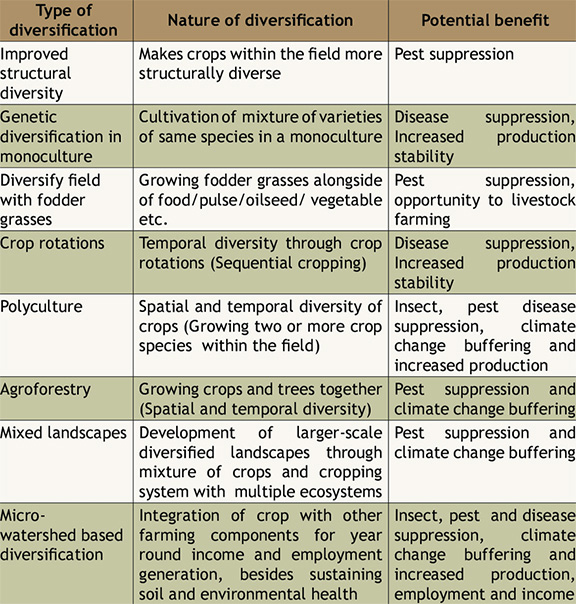Agriculture
Crop Diversification
- 27 Apr 2021
- 6 min read
Why in News
Recently, a top agriculture economist has suggested that the best chance of Crop Diversification is through animal agriculture/animal husbandry.
Key Points
- About:
- Crop diversification refers to the addition of new crops or cropping systems to agricultural production on a particular farm taking into account the different returns from value- added crops with complementary marketing opportunities.
- Cropping System: It refers to the crops, crop sequences and management techniques used on a particular agricultural field over a period of years.
- Types: Major cropping systems in India are sequential-cropping, monocropping, intercropping, relay Cropping, mixed-cropping and alley cropping.
- Many farmers also use the mixed crop-livestock system to increase their standards of living and income.
- Animal husbandry or Animal Agriculture is the branch of science dealing with the practice of breeding, farming and care of farm animals (livestocks) such as cattle, dogs, sheep and horses by humans for advantages.
- It refers to livestock raising and selective breeding. It is a branch of agriculture.
- Crop diversification refers to the addition of new crops or cropping systems to agricultural production on a particular farm taking into account the different returns from value- added crops with complementary marketing opportunities.
- Types:
- Benefits:
- Increase Income on Small Land Holding:
- At present, 70-80% farmers have land below 2 hectare. To overcome this, existing cropping patterns must be diversified with high value crops such as maize, pulses, etc.
- The Government of Haryana has also supported this by announcing that farmers switching to other alternate crops instead of paddy will be paid Rs. 7000 per acre incentive (Mera Pani - Meri Virasat Scheme).
- Economic Stability:
- Crop diversification can better tolerate the ups and downs in price of various farm products and it may ensure economic stability of farming products.
- Mitigating Natural Calamities:
- Sudden adverse weather conditions like erratic rainfall, drought, hail, incidence of insect and pest disease. Under this situation, crop diversification through mixed cropping may be useful.
- Balance Food Demand:
- Most of the Indian population suffers from malnutrition. Most of the girl children have anemia. Including crops like pulses, oilseed, horticulture, and vegetable crops can improve socio economic status by adding quality to the food basket and also improve soil health with the aim of food safety and nutritional security.
- The Government of India has now targeted to increase the area under pulses and oilseeds through National Food Security Mission (NFSM).
- Conservation:
- Adoption of crop diversification helps in conservation of natural resources like introduction of legume in rice-wheat cropping system, which has the ability to fix atmospheric Nitrogen to help sustain soil fertility.
- Soil Health Card (SHC) provides information to farmers on nutrient status of their soil along with recommendations on appropriate dosage of nutrients to be applied for improving soil health and its fertility.
- Increase Income on Small Land Holding:
- Challenges:
- Majority cropped area in the country is completely dependent on rainfall.
- Sub-optimal and over-use of resources like land and water resources, causing a negative impact on the environment and sustainability of agriculture.
- Animal agriculture is the second largest contributor to human-made Greenhouse Gas (GHG) emissions after fossil fuels and is a leading cause of deforestation, water and air pollution and biodiversity loss.
- Inadequate supply of seeds and plants of improved cultivars.
- Fragmentation of land holding less favouring modernization and mechanization of agriculture.
- Poor basic infrastructure like rural roads, power, transport, communications etc.
- Inadequate post-harvest technologies and inadequate infrastructure for post-harvest handling of perishable horticultural produce.
- Very weak agro-based industry.
- Weak research - extension - farmer linkages.
- Inadequately trained human resources together with persistent and large scale illiteracy amongst farmers.
- Host of diseases and pests affecting most crop plants.
- Poor database for horticultural crops.
- Decreased investments in the agricultural sector over the years.
- Other Related Initiatives:
Way Forward
- Although there are challenges which can not be ignored, crop diversification provides an opportunity to double farmers income and create food security for the nation.
- Therefore, the government must promote crop diversification by purchasing crops produced other than wheat and rice at Minimum Support Price. This could also help conserve the dwindling supply of underground water.
- Agricultural emissions can also be limited through smarter livestock handling, technology-enabled monitoring of fertilizer application, simple changes in field layout and other, more efficient agricultural techniques.





